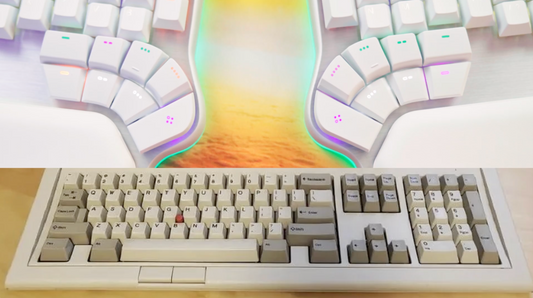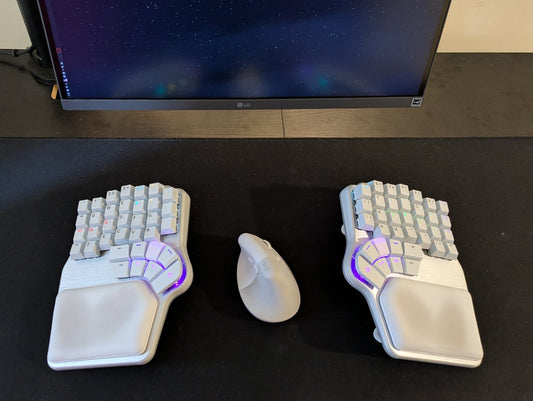Since we announced our next big hit, the Raise 2, we've been flooded with questions, reflecting the immense enthusiasm surrounding our keyboard. Now it's time for us answering the 13 most intriguing and commonly asked questions.
1. When can I buy it?
The Raise 2 Launch Campaign is live, so you can pre-order your Raise 2 anytime 🎉
However, the campaign runs until April 25th, and during this period, you can get your keyboard at a special discounted price.
And keep in mind we will no longer be producing the original Raise. From this point, we'll only make the Raise 2 and the Defy.
2. Is there any form of a 'trade-in' program for the OG Raise?
We're sorry to say that after running the numbers, the logistics, the shipping costs, and taxes, we've found it impossible to offer a satisfactory voucher for the trade.
However, you can always sell the OG Raise on platforms with an excellent secondhand market value. You can even sell its parts separately for a higher price!
3. Will the Raise 2 be bigger than the original Raise?
The Raise 2 is pretty much the same size as the original Raise, possibly a millimeter of difference in thickness.
You can check the exact size of the Raise 2 by downloading this printable PDF that'll give you a hands-on comparison.
4. How much does it cost?

The price of the Raise 2 is very similar to the Defy, which starts at $369.
But now, we have great launch discounts: the base Raise 2 costs $299 (that's $70 off retail), and each add-on costs an additional $70.

Configure your dream keyboard and save up to $110 🤩
Also, the first 3000 orders will get free shipping, so make sure you don't miss that 😊
5. How sturdy is the tenting, and how does it work?
First of all, we at Dygma never make anything that isn't sturdy AF. Our tenting kits are designed to be robust, providing stability from all angles up to 60 degrees. Both the tenting and reverse tilting can be set up in seconds, providing a far more comfortable all-around desktime experience.

6. What are the differences between the Raise 2 and the Defy?
The major difference between the two is the layout. As you can see, the Raise 2 has a more traditional, staggered layout, while the Dygma Defy has a more ergonomic, columnar layout.
The Raise 2 has 8 thumb keys, while the Defy has 16.
And the split itself is also a major difference.

The Raise 2 can be connected at any time to resemble a more traditional 60% keyboard; meanwhile, with the Defy, the split is permanent and cannot be attached. This makes the Raise 2 a great gateway into keyboard ergonomics.
If you're curious about which of these two programmable keyboards suits you better, check out our video.
7. Is the Raise 2 fully programmable?
Yes, it is fully programmable. By using our ever-updating software Bazecor, users can assign and reassign keys, program their own layers, macros, and superkeys, and jazz up their keyboard on an aesthetic level with various colors.
Bazecor is compatible with Linux, Mac, and Windows platforms. It's completely open-source, which allows programmers and coders to contribute if desired.

As a side note, while Bazecor is needed to configure the Raise 2, it's not required to run the keyboard. The Raise 2 is described as plug-and-play, and once configured, it can be used without the software running continuously.
8. If it's wireless, how is it connected?
The Neuron serves as the dongle for the Raise 2. When connected to the computer, it acts as an RF transmitter, and when plugged into the keyboard, it functions as a Bluetooth transmitter.
This device facilitates both wired and wireless connections. The wireless system for gaming on the Raise 2 will be similar to the Defy, aiming for low latency. The current firmware shows around 10 milliseconds of latency, with ongoing efforts to reduce it further.

And while we're on the topic of wireless, let's briefly mention the battery life. The battery life of the Raise 2 keyboard is contingent on the usage of LEDs.
At full LED brightness, the current framework offers approximately 10 hours of usage. However, the new firmware will double the battery life to around 20 hours under similar conditions. For users opting for lower LED brightness, such as 50%, the new firmware is reported to provide around 10 to 11 hours of daily usage, resulting in approximately a week of battery life. And our plan is to make it grow to multiple weeks.
9. As for gaming, have you found the Raise 2 to improve your performance?
As a first-person gamer, you may find a mild learning curve when transitioning to any ergonomic keyboard. Once the initial hump is conquered, you'll find that both the Defy and the Raise 2 are recognized as extremely effective for gaming.

An improved posture is a sure-fire way to boost anyone's overall gaming experience. But the programmable keys, hot-swappable switches, and even the LEDs have all been shown to improve gameplay massively, too.
10. What keycap profile will you use?
The decision for the keycap profile is still open. There's a consideration between OEM profile, PBT double-shot, Cherry profile, and ABS keycaps. All of which will vary the height or thickness of the Raise 2.

The choice between these profiles is something that the community can influence, and the decision is not final.
11. Why did you add pogo pins to it?
The Raise 2 is confirmed to be expansion-ready. This aspect is aimed at future-proofing the Raise 2, allowing for the development of modules later down the line. While specific modules are in the early stages of prototyping, one example is a trackball.

The expansion concept is intended to be versatile, so we encourage the community to let us know if they have any ideas or suggestions. We don't expect to have it ready for the launch, but the goal is to introduce modules in the future as part of the expansion-ready design.
12. What colors will it be available in?
We're thinking about the possibility of color variations for the Raise 2, but it also depends on the manufacturing limits and challenges faced with different configurations. Obviously, our main goal is to make different switches, languages, and keycaps available.

13. What firmware does the Raise 2 use? Is it QMK or ZMK?
We make our own firmware that's a fork from Kaleidoscope.
For those of you who don't already know, QMK and ZMK are open-source firmware for customizable mechanical keyboards. They allow users to personalize key layouts and functions. QMK is widely used and flexible, while ZMK is another option developed by Zambumon.
The chips used in the original Raise were not compatible with QMK, but for the Defy and the Raise 2, we use RP2040 chips, which are compatible with QMK. So, as it is open-source, it may be possible to support QMK, but it's currently not a priority for us.
We arrived at the end of the 13 most common questions - time really flies when you have fun. We hope it was useful and we could answer all your questions. If you are still curious about something, feel free to ask us on Discord or Reddit.









